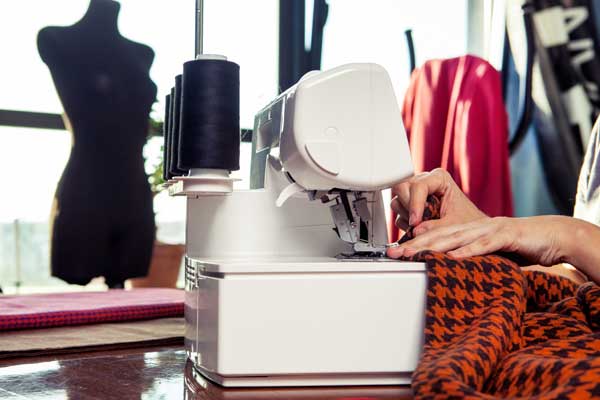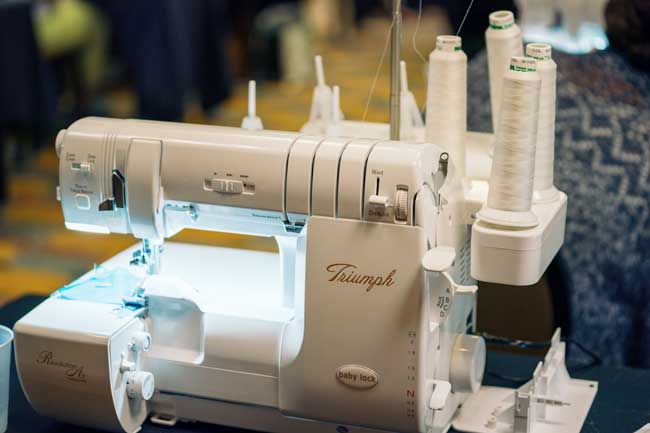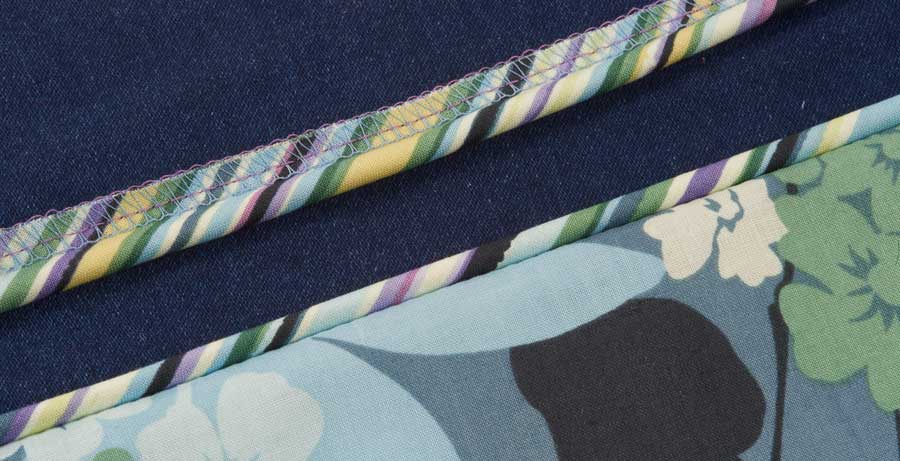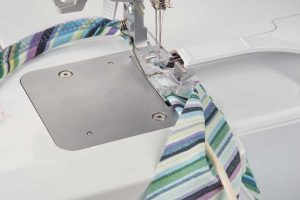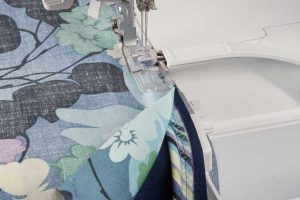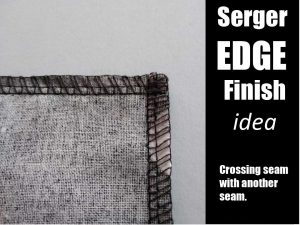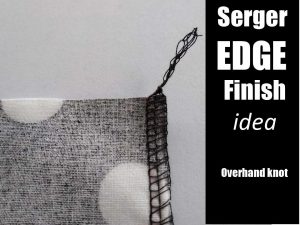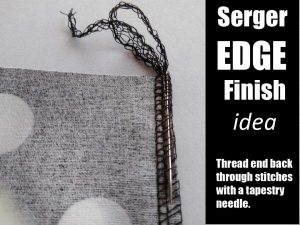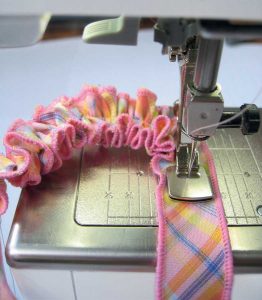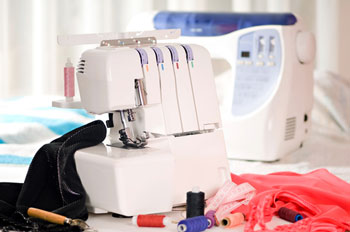 When I first saw a home serger back in the 1980’s, I knew I NEEDED it! OK, maybe it was more WANTED than needed, but I definitely wanted one and my enthusiasm for this machine has only grown over the years. And while I treasure my serger, I’ve wondered why many sewists have never used one or, if they do have one, why it’s often stored in the back of the closet, still in the box. While we all love sewing, why do some just never take to this machine while others can’t live without it? April is National Serger Month, so let’s take a look at the serger and see what may be splitting us into advocates and critics and what we need to know to bring this machine in to the light.
When I first saw a home serger back in the 1980’s, I knew I NEEDED it! OK, maybe it was more WANTED than needed, but I definitely wanted one and my enthusiasm for this machine has only grown over the years. And while I treasure my serger, I’ve wondered why many sewists have never used one or, if they do have one, why it’s often stored in the back of the closet, still in the box. While we all love sewing, why do some just never take to this machine while others can’t live without it? April is National Serger Month, so let’s take a look at the serger and see what may be splitting us into advocates and critics and what we need to know to bring this machine in to the light.
April is National Serger Month
I saw that first serger at a Stretch & Sew class my mother had dragged me to in the hope that I might become interested in sharing her love of sewing. Mom was an amazing seamstress who could work miracles with a needle, thread, and fabric. She created garments, from tailored jackets and suits to gowns; home dec, including pinch pleat drapes; and even upholstery. And whatever she made was always perfect. For me, the tedious steps and handwork in sewing drove me crazy. But, for this particular trip, being out with Mom, even for sewing, was more fun than a day with restless kids and housework.
Enter Stretch & Sew
In this class, I learned that Stretch & Sew patterns were simple, the techniques were easy, and the serger made them even faster than a sewing machine. The instructor assured us that we could whip up a knit shirt in less than an hour. It was love at first sight! Unfortunately, my mother who normally loved new gadgets, was less impressed. It didn’t occur to me until later that when it comes to sergers, a person’s sewing interests and personality have more to do with their compatibility with sergers than simply their interest in sewing.
That Christmas, dad bought 2 sergers, one for me and one for mom. We took classes together and learned to operate this new machine and while I embraced it totally, she merely tolerated it. The serger’s ability to clean finish and construct a seam at the same time was a time-saving feature for me—a definite plus. Mom preferred the look of a pinked or other hand finished tailoring seam that she could do in the evening while watching TV. She didn’t want to let go of her traditional sewing methods and was an advocate of slow sewing even before the term became popular. For me, a young working mom with kids who had to be chauffeured, fed, watered, schooled, etc. though, the serger was a hobby I could do at home in those precious few stolen minutes of down time.
 Having grown up in the Flower Power generation, I wanted the free flowing clothing that was easily constructed with the serger and I loved the sweatshirts and T’s I could make for the whole family. Knits became the lure that created my passion for sewing, especially since the serger and knits were made for each other. With the serger more suited to what I created than those tailored jackets that my mom produced, it was no wonder I began to explore more and more uses for my new friend. Sweater bodies (yarn knitted yardage) on the serger resulted in beautiful sweaters that looked hand knitted. When Stretch & Sew started focusing on more patterns for wovens that included instructions for working with sergers, I used these new methods for more business style clothing like dresses and blazers since I had gone back to a full-time job.
Having grown up in the Flower Power generation, I wanted the free flowing clothing that was easily constructed with the serger and I loved the sweatshirts and T’s I could make for the whole family. Knits became the lure that created my passion for sewing, especially since the serger and knits were made for each other. With the serger more suited to what I created than those tailored jackets that my mom produced, it was no wonder I began to explore more and more uses for my new friend. Sweater bodies (yarn knitted yardage) on the serger resulted in beautiful sweaters that looked hand knitted. When Stretch & Sew started focusing on more patterns for wovens that included instructions for working with sergers, I used these new methods for more business style clothing like dresses and blazers since I had gone back to a full-time job.
Don’t touch that dial!
In an early serging class I attended, the instructor frightened us into believing that the tension controls should never be moved. But why would the manufacturer make an adjustable dial that shouldn’t be touched? Although I’m not a rebel, it wasn’t hard to figure out that even if you adjusted the dial, it was easy enough to return it to the original setting by rotating back to the original number on the dial. A few years later, another instructor suggested we thread the machine with contrasting colors of thread, setting the tension dials to 0, and then changing just one dial at a time so that we could easily see what each adjustment did and which thread was affected. That empowering knowledge assured we could make the machine adapt to whatever fabric we were working with.
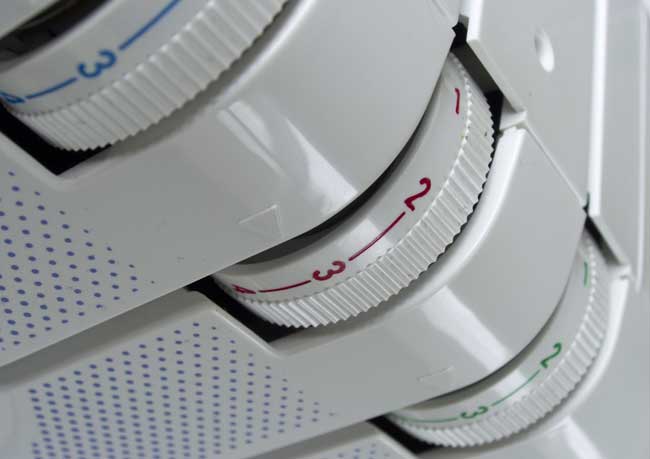
Many serger owners are a bit intimidated by the machine’s tension dials and, unfortunately, never learn its full capabilities. I’ve now switched from taking serger classes to giving them and I include the tips I learned in my classes so that no one is doomed to poor stitching just because of various weights of fabrics and thicknesses of seams. For those who use their machines for clean finishing seam allowances only, having to adjust the tension may cause you to move that serger to the back of the closet. The good news is that manufacturers recognize the worry about tension dials and many have now developed a self adjusting tension feature on new machines to alleviate that concern. Special sensors can determine the thickness of the fabric and automatically adjust the tension without the operator touching a dial. But even if your machine is missing that feature, don’t be afraid to rotate those dials and experiment!
But, now I want blue
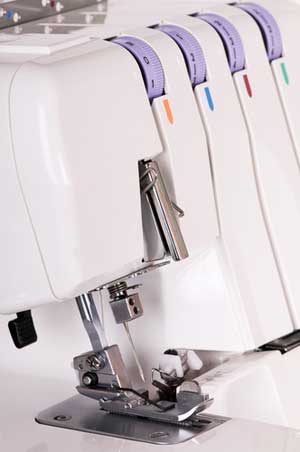 The next biggest fear of serger owners is changing threads. On a 4-thread serger, the first two spools are for the needles. Threading the needle is much the same as it is a traditional sewing machine—the thread paths are very similar except for the telescoping guide above the thread cone. The remaining two spools are for the loopers (the thread path that comes from below and creates the overlock) and can be a little more involved to thread. However, most all machine have color coded pathways to indicate the proper thread paths so you can start at the spool and follow the same colored dots all the way to the needles. And just like the tensions, many manufacturers now offer air threaders that allow the user to insert the thread into a hole, press a button, then find the thread at the looper all ready to go.
The next biggest fear of serger owners is changing threads. On a 4-thread serger, the first two spools are for the needles. Threading the needle is much the same as it is a traditional sewing machine—the thread paths are very similar except for the telescoping guide above the thread cone. The remaining two spools are for the loopers (the thread path that comes from below and creates the overlock) and can be a little more involved to thread. However, most all machine have color coded pathways to indicate the proper thread paths so you can start at the spool and follow the same colored dots all the way to the needles. And just like the tensions, many manufacturers now offer air threaders that allow the user to insert the thread into a hole, press a button, then find the thread at the looper all ready to go.
So, do you need a serger?
A serger can be a little like a microwave. The microwave doesn’t replace the regular oven, and neither does a serger replace a regular sewing machine. While some sergers are only used for finishing seam allowances, they can also contribute to the creation of many clothing items, purses, totes, baskets, curtains, pillows, quilts, baby items, and masks, and can even be used to insert a zipper! I have used the serger to do rolled hems on garments and home dec items, and the flatlock technique has decorated shirts, inserted lace for a mock heirloom look, and created fleece blankets with “invisible” seams.
After so many years with this old friend, I guess I can say that I really did NEED that serger back then. And I do believe that anyone who sews can benefit from a serger if you only allow yourself to use it. So if you have a serger sitting in the closet all alone, bring it out for National Serger Month and explore all the possible ways you might be able to get acquainted. The ASG National Conference often features serger classes from some of the leading experts if you need some help. For inspiration, check out Gail Yellen and Deb Canham who have books, patterns, and YouTube videos available. Then take this brief quiz to determine your compatibility to sergers. The more “no’s” you answer, the more likely you are to enjoy a serger. Happy serging!
- Are you a traditionalist? Do you believe that all sewing must be done in the old, time tested methods?
- Do you prefer hand sewing to machine sewing?
- Are you intimidated by machines?
- Does playing with dials to see what they do scare you?
- Are you an advocate of “slow sewing”?
- Do you prefer to stick to what you know rather than try something new?
- Are you overwhelmed when you have to re-thread a sewing machine?
- Does playing with new techniques seem like a waste of time?
- Do you follow the “I can’t touch it, I might break it” philosophy?
- Are you content to remain sewing the way you always have?
~Rosemary Fajgier





